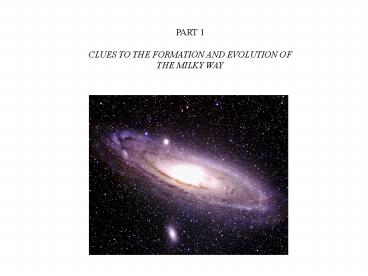CLUES TO THE FORMATION AND EVOLUTION OF THE MILKY WAY - PowerPoint PPT Presentation
1 / 14
Title:
CLUES TO THE FORMATION AND EVOLUTION OF THE MILKY WAY
Description:
This scenario is based upon observations of the motions, ages, metalicities of ... that stars and star clusters are formed right smack in the middle of spiral arms. ... – PowerPoint PPT presentation
Number of Views:78
Avg rating:3.0/5.0
Title: CLUES TO THE FORMATION AND EVOLUTION OF THE MILKY WAY
1
PART 1 CLUES TO THE FORMATION AND EVOLUTION OF
THE MILKY WAY
2
This scenario is based upon observations of the
motions, ages, metalicities of stars as a
function of their locations in the galaxy. There
are very clear trends in these observables.
3
The motions of disk stars are in a plane. The
motion of Halo stars and clusters are elliptical
about the center.
4
Constructing a Model of the Galaxy and its
Formation.
Two Populations of Stars Pop I and Pop II. Pop
I stars are younger, formed as a later
generation, and have higher metal content. Pop II
stars are older, formed in first generation, and
have lower metal content. Pop I stars are
located in the galaxy disk where stars are
continually forming. Pop II stars are located in
the bulge, halo, and globular clusters.
Pop I
Pop II
Extreme Intermediate
Property
Intermediate Extreme
Location Spiral Arms Disk
Bulge Halo Metals
() 3 1.6
0.8 lt0.8 Orbit
shape circular slight
moderate highly
elliptical
elliptical
elliptical Average Age 100 million
0.2-10 billion 2-10 billion 10-14
billion (yrs) and younger
5
Heavy Element build up in the Galaxy
Pop II stars are formed first when the Galaxy is
contracting from the intergalactic medium.
They reside in the halo and bulge (elliptical
orbits) and since they formed first, they are
made of primarily hydrogen and helium (light
elements). As the galaxy flattened, 2nd and 3rd
generation stars were formed (Pop I stars).
These formed from gas that was enriched by Pop II
stars! So, Pop I stars have heavier elements in
them. Stars are very efficient at making carbon,
nitrogen, oxygen, and iron (in the massive stars).
6
And now you know the story...
- Old, low mass, low metallicity, elliptical orbit
stars in the bulge and halo - Younger, wide mass range, wide metallicity range,
planar orbits in the disk. - This should now be an intuitive picture in your
mind.
Note the colors the globular clusters and bulge
are reddish (cool low mass stars that are old)
whereas the disk stars are both blue (hot high
mass that are young) and reddish.
7
PART 2 SPRIAL ARMS STRUCTURE AND STAR
Dude, Galactic radio is the ultimate! Hydrogen
Rocks!
8
Spiral Arms
How do we measure their locations? How do they
form? How are they sustained over many rotations?
9
Hydrogen in the Radio Band! 21-cm Radiation The
best way to structure in the Galaxtic Disk is to
observe the hyperfine structure of the hydrogen
atom. The magnetic fields lines of the
spinning electron and proton interact. When the
fields are aligned magnetic energy is tense when
fields are opposite magnetic energy is relaxed.
Energy Difference is very low the light emitted
is in the radio band
High energy (excited) state.
Low energy (ground) state.
When the electron flips from the excited state to
the ground state, energy is released. The energy
is carried off by a photon (light) with a
wavelength of 21-cm (radio).
10
Using radio waves works well because radio waves
pass right through gas and dust clouds (whereas
visible light does not). RADIO PHOTONS DO NOT
SUFFER INTERSTELLAR EXTINCTION Thus, we can see
right through the interstellar medium and measure
the locations of all the clouds, which all have
lots of neutral hydrogen. NOTE HIGH LEVEL OF
STRUCTURE! CAUTION this requires a model of
the galactic rotation to work and that is
subject to some uncertainty and assumptions.
Location of Hydrogen Clouds
11
Spiral Arms are Traced out by O and B Stars
When one maps out the location of nearby O and B
stars, we find that they align along the spiral
arms of the Galaxy. Objects that lie in the
spiral arms with which we can map them out are
called spiral tracers. All tracers are very
young objects.
This would imply that stars and star clusters are
formed right smack in the middle of spiral arms.
As they age they must migrate out of the arms.
12
This beautiful scene brings out a clear view of
the spiral arms and gas clouds in the foreground
galaxy. Note that the spiral arms are bright
with O and B stars. Note also the great amount
of gas and dust in the galaxy disk.
13
A model of Star Formation in Spiral Arms
This is called density wave theory. Basically,
the spiral arms are congested areas. As gas
complexes collide with the spiral arms the shock
waves, etc. triggers stars formation. Then the
relative life times of high mass and low mass
stars goes into effect
1
4
2
5
3
The reason this theory is needed is because the
spiral arms would dissipate in about 1 billion
years.
14
Complex Structure of Spiral Arms
Much structure is seen in spiral galaxies that is
not easily explained by the density wave theory.































